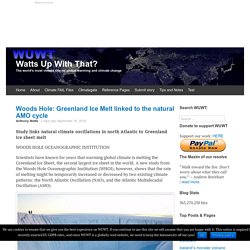

Greenland melting likely increased by bacteria in sediment – Watts Up With That? Microbes in meltwater stream sediment may help boost island’s contribution to sea-level rise Research News Bacteria are likely triggering greater melting on the Greenland ice sheet, possibly increasing the island’s contribution to sea-level rise, according to Rutgers scientists.

That’s because the microbes cause sunlight-absorbing sediment to clump together and accumulate in the meltwater streams, according to a Rutgers-led study – the first of its kind – in the journal Geophysical Research Letters. The findings can be incorporated in climate models, leading to more accurate predictions of melting, scientists say. “These streams can be seen all over Greenland and they have a brilliant blue color, which leads to further melting since they absorb more sunlight than the surrounding ice,” said lead author Sasha Leidman, a graduate student in the lab of co-author Asa K. With climate change, sea-level rise and coastal storms threaten low-lying islands, cities and lands around the world. Related. New Studies Show Cloud Cover Changes Have Driven Greenland Warming And Ice Melt Trends Since The 1990s.
Scientists now acknowledge cloud cover changes “control the Earth’s hydrological cycle”, “regulate the Earth’s climate”, and “dominate the melt signal” for the Greenland ice sheet via modulation of absorbed shortwave radiation.

CO2 goes unmentioned as a contributing factor. Image Source: Hahn et al., 2020 Climate modeling of factors influencing Greenland warming, surface melt have been 100% wrong A few years ago scientists acknowledged “a major disparity in trends between models from the Coupled Model Intercomparison Project 5 (CMIP5) and observations for the last 20-30 years” (Hanna et al., 2018). All 36 climate models simulating blocking over Greenland were wrong.
Greenland--Geothermal Influences of Ice Sheet Melting. Migrating snowline plays outsized role in setting pace of Greenland ice melt. Another alarmist pillar collapses – Greenland melting due to old soot feedback loops and albedo change – not AGW. From the EARTH INSTITUTE AT COLUMBIA UNIVERSITY and the “we told you so time and again at WUWT” department comes this study which not only explains the “insta-melt” in the Summer of 2012, but the ongoing melting that has been incorrectly blamed on CO2, when instead it’s all about older soot embedded in snow coming around again to enhance melting combined with weather pattern changes..

An aerial image of Greenland shows rivers of meltwater and areas of dark ice. Greenland’s surface is absorbing more solar radiation as melting increases grain size and brings old impurities to the surface. CREDIT Marco Tedesco/Lamont-Doherty Earth Observatory Greenland’s ice is getting darker, increasing risk of melting Feedback loops from melting itself are driving changes in reflectivity Greenland’s snowy surface has been getting darker over the past two decades, absorbing more heat from the sun and increasing snow melt, a new study of satellite data shows.
Like this: Like Loading... Scientists Now Assert Natural Mechanisms Have Driven The Recent Retreat Of The Greenland Ice Sheet. By Kenneth Richard on 30.

August 2018 Scientists are increasingly concluding that changes in low level cloud cover, not CO2, are what govern the surface radiation budget in the polar regions, driving and determining the retreat of the ice sheets. Image Source: It is considered “established science” that “the greenhouse effect of clouds may be larger than that resulting from a hundredfold increase of the C02 concentration of the atmosphere” (Ramanathan et al., 1989, 1,647 citations to date). Indeed, satellite observations indicate that the Earth’s “radiation budget changes are caused by changes in tropical mean cloudiness” (Wielicki et al., 2002), not CO2 concentration changes.
Woods Hole: Greenland Ice Melt linked to the natural AMO cycle. Study links natural climate oscillations in north Atlantic to Greenland ice sheet melt Scientists have known for years that warming global climate is melting the Greenland Ice Sheet, the second largest ice sheet in the world.

A new study from the Woods Hole Oceanographic Institution (WHOI), however, shows that the rate of melting might be temporarily increased or decreased by two existing climate patterns: the North Atlantic Oscillation (NAO), and the Atlantic Multidecadal Oscillation (AMO). Scientists stand on the edge of a crevasse formed by meltwater flowing across the top of the Greenland Ice Sheet during a WHOI-led expedition in 2007. (Photo by Sarah Das, Woods Hole Oceanographic Institution) Both patterns can have a major impact on regional climate. “We know the Greenland ice sheet is melting in part because of warming climate, but that’s not a linear process,” Ummenhofer said. Actually forecasting environmental conditions on a decadal scale isn’t easy. Like this: Like Loading...
Enormous Aquifer Discovered Under Greenland Ice Sheet. An ice core segment extracted from the aquifer by Koenig’s team, with trapped water collecting at the lower left of the core.Image Credit: NASA’s Goddard Space Flight Center/Ludovic Brucker From NASA, I had to laugh at this statement:

More (un)settled science…fewer clouds mostly responsible for Greenland ice melt.